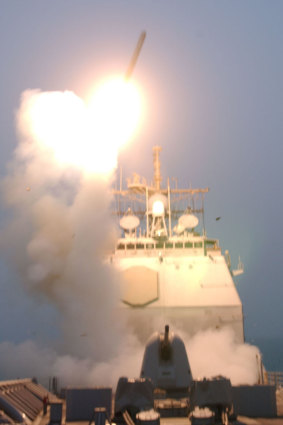This was published 4 years ago
From the Archives, 2003: Invasion begins, US missiles blitz Baghdad
The invasion of Iraq began when at least five cruise missiles slammed into the heart of Baghdad. The Herald’s correspondents reported from Baghdad and the Kuwait/Iraq border.
By Paul McGeough and Lindsay Murdoch
First published in The Sydney Morning Herald, March 20, 2003
By our correspondents, Paul McGeough, in Baghdad, and Lindsay Murdoch, on the Kuwait/Iraq border
At least five cruise missiles slammed into the heart of Baghdad this morning, setting two government buildings
ablaze and stabbing at the heart of the regime Saddam Hussein’s palace compound on the banks of the Tigris River but still not “shock and awe”.
The force of the missiles, low powered compared with some of the massive warheads promised by the US, pointed to a new turn in the Bush battle plan, after a surprise opening missile strike earlier in the day on a military complex on the outskirts of the city.

The first Tomahawk missile to be fired into Iraq is launched from the USS Bunker Hill.Credit: Richard Moore, US Navy
US and British troops invading from Kuwait seized the Iraqi border town of Umm Qasr this morning, the official Kuwaiti News Agency said. Iraqi state television denied that the town had fallen.
Meanwhile, US forces launched a massive artillery assault on Iraqi positions near the Kuwait border early today. Artillery units of the US First Marine Division fired a barrage of 200 rounds from heavy howitzers.
Their target was the Iraqi 51st Mechanised Division across the border. As well, American Apache attack helicopters launched Hellfire missiles into the Iraqi positions. The massive assault lit up the sky with bright orange explosions in an awesome display of firepower which continued for two hours.
In Baghdad, air raid sirens wailed at 8.48pm and 20 minutes later as a building, thought to be the headquarters of Saddam’s oil ministry, was engulfed in a massive fire ball. The missiles whipped in from the south, exploding with a low percussion thud that reduced the building to ghostly flames and a plume of smoke.
The next target was only metres away and it too went up in a spectacular hit, minutes later. This building, which earlier in the day boasted two anti-aircraft batteries which were stationed on its rooftop, and the oil ministry, are next to Saddam’s planning headquarters, where the Jumhuriya bridge meets the west bank of the river.
A short time later, two missiles appeared to slam into the presidential compound itself. The chances of the security paranoid Saddam or members of his family being on the premises at a time like this are zero, but there were reports that a house in which the president’s wife and daughters lived was hit.
Baghdad the regime and the city emerged dazed from the first US strikes and fearful of what might be in store for them in the coming night.
Iraqi forces had retaliated in the wake of the opening US assault, firing three Scud missiles into Kuwait, one of which was taken out by a US-operated Patriot missile battery before it neared Kuwait City. The two reportedly landed harmlessly in the deserts of north Kuwait.
Light traffic returned to Baghdad’s streets, but only for the daylight hours. The telephone system either was shut down or on the brink of collapse international calls were impossible; local calls were a lottery.
Foxholes and barricades were still being built around the city and what the Herald presumed to be waste cardboard on a busy intersection proved to be a foxhole when several soldiers were seen emerging from beneath it.
Iraqi officials said that one person had died and several had been injured in US-led attacks on a customs post on the Jordanian border and on a TV station at Ramadi, a Saddam stronghold west of Baghdad. There was further scattered US bombing beyond Baghdad in the mid-afternoon, but the day’s strikes were focused on the Al Rasheed military complex, about 15km south-east of the capital, and, according to Iraqi street talk, an elaborate presidential palace next to Saddam International Airport.
Reports from Washington say that the CIA was convinced that it had a surveillance fix on Saddam in a bunker within the complex.
Both sites are close to one of Saddam’s more impressive personal security facilities the palace is cheek-by-jowl with the airport, from which a French construction contractor built Saddam two escape routes in the mid-80s, a tunnel and a separate access road.
A hectoring Information minister, Mohammed Saeed al-Sahhaf, accused Mr Bush of deliberately attempting to assassinate Saddam.
“Bush has committed a despicable crime against humanity. The only way to describe the rulers of the US and Britain is that they are mercenaries and war criminals,” he said.
Like most of his colleagues, Mr al-Sahhaf arrived at a press conference in the drab military ensemble of the Baath Party.
Most senior officials have switched to the same garb even the director general of information, Uday al-Taie. Yesterday he arrived at work in the early hours in a smart suit and tie. By mid-morning he too was in fatigues.